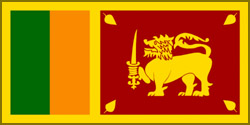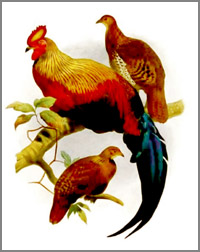|
Our National Symbols: Pride of the nationSYMBOLS OF PRIDE: Technically, a national emblem symbolically represents a nation. Our National Symbols go much further. They are representative not only a nation but also its rich history and culture. They define us as a people - who can be proud of who we are. The national symbols are wide and varied, from black double-headed eagle of Albania to Water buffalo in Vietnam, golden wattle in Australia to flame lily in Zimbabwe. Sri Lanka, too, has many national emblems. This article reviews the most important of them - the National Flag, National Anthem, National Tree, National Bird and National flower. National FlagIt is said that when Vijaya, the first King of the Sinhalese people, arrived in Sri Lanka in 486 BC, he brought with
him a flag with a symbol of a lion on it. Since then the Lion symbol played a significant role in the history of Sri Lanka. It was used extensively by monarchs who followed Vijaya and it became a symbol of freedom and hope. Even the legendary King Dutugemunu carried with him a banner which portrayed a lion carrying a sword on his right forepaw along with two other symbols, the Sun and the Moon. The last Sri Lankan King to use the flag was King Sri Vikrama Rajasinghe, who was also the last King of Sri Lanka. When his reign was brought to an end by the British in 1815, they replaced the Lion flag with the Union Jack as the national flag of Sri Lanka. The Lion Flag was taken to England and kept at the Royal Military Hospital in Chelsea. As the independence movement in Sri Lanka gained strength in the early 20th Century, E. W. Perera, a prominent figure of the independence movement, discovered the original Lion flag in Chelsea.
A picture of it was subsequently published in a special edition of the Dinamina newspaper to mark 100 years since the end of Sri Lankan independence. The Lion flag then became a centrepiece of attraction to the public, who for the first time since the fall of the Kandyan Kingdom were now aware of its actual design. On 16th January 1948, Mr. A. Sinnalebbe, MP for Batticaloa tabled a motion in the State Council suggesting that the Lion Flag of King Sri Wickrama Rajasinghe should be made the National Flag. (It had a lion in yellow holding a sword in its right forepaw, on a crimson background. Four pinnacles also in yellow were at the four corners with a border running right round). The MP's point was debated in the Council and later Prime Minister Rt. Hon. D.S. Senanayake named an Advisory Committee for the formulation of a National Flag. The Members of the Committee were S.W.R.D. Bandaranaike (Chairmen), Sir John Kotelawala, J.R. Jayewardene, T.B. Jayah, Dr. L.A. Rajapakse, G.G. Ponnambalam and Senator S. Nadesan, and Dr. Senarath Paranavithana (Secretary). The Committee was not in a position to formulate the National flag before the Day of our Independence - 4th February 1948. However the Lion Flag and the British Union Jack fluttered on the occasion of the opening of the first Parliament of independent Sri Lanka (then Ceylon) on February 11th, 1948. Prime Minister D.S. Senanayake unfurled the Lion Flag at the Patthirippuwa during the Independence celebrations held in Kandy on February 12th, 1948. The National Flag recommended by the special committee was presented to Parliament by D.S. Senanayake on March 2, 1951 and was adopted. It had two strips, one green and the other yellow. Each of these strips had to be equal to one-seventh the size of the flag. When Sri Lanka was first made a Republic in 1972 the stylised Bo Leaves depicted in the National Flag were changed to resemble natural Bo leaves. The amended flag was first unfurled at the Republic Day celebrations held on May 22nd, 1972. National AnthemNational Anthems have truly only one purpose - to instil patriotism and nationalism in the hearts of the citizens. Breaking away from colonial rule in the late 1940s, the people of Sri Lanka were kindled with patriotic fervour. Of course, one of the first steps of any new nation-state in the postcolonial world was to find a lyric expression of its status of independence. On the recommendation of the Sri Lanka Gandharva Sabha, a competition to select a national anthem was conducted in January 1948. At this competition Ananda Samarakoon's composition "Namo Namo Matha" was chosen as the National Anthem on 22nd November 1951. The first public rendering of the national anthem was made on Independence Day, 4 February 1952, by a group of 500 students from Museus College, Colombo, and was broadcast over radio. Later as a result of a controversy, the opening words were changed as "Sri Lanka Matha - Apa Sri Lanka". National FlowerIn February 1986 Nil Manel or blue water lily (Nymphaea stellata, though it has been recently renamed as
Nymphaea nouchali) was chosen as the National flower. Nil Manel is found all the part of Sri Lanka and grows in the shallow water. Petals are arranged like a star and the flat round waterproof leaves are bright green. Throughout the history its been regarded as a symbol of purity and truth. It has a sweet fragrance and used for offering at Buddhist Temples and rituals for god Vishnu. We find the Apsaravas in Sigiriya frescoes holding these flowers in their hands. Seeds and the tubes are used as a vegetable by villagers while leaves, stem and flowers are used in herbal medicine. Clearly the Manel flower is prominent among diverse cultures. It is seen as a metaphor for the possibility of enlightenment even among conditions of imperfection since the flower emerges as a beautiful and luminous symmetric form from dark and muddied waters. Hindu traditions also adopted it as a central icon where it's often used as a symbol of divine creation. National TreeNa tree (Mesua Ferrea) was named as the National Tree in 1986. The plant is named after the heaviness of its
timber and cultivated in tropical climates for its form, foliage, and fragrant flowers. It is native to tropical Sri Lanka, India, southern Nepal, Indochina, and the Malay Peninsula. It is a small to medium-sized evergreen tree up to 13 m tall, often buttressed at the base with a trunk up to 90 cm in diameter. It has simple, narrow, oblong, dark green leaves, with a whitish underside; the emerging young leaves are red to yellowish pink and drooping. The flowers have white petals and a centre of numerous yellow stamens. The National Na tree Forest is a 96 ha (238 acre) forest in Sri Lanka where Na trees dominate the vegetation. It is said that during King Dappula IV's period (8th century AD) this forest was created and the remaining trees are the shoots of it. Hence it is considered the oldest manmade forest in Sri Lanka. It's also believed that during Buddha's first visit to Mahiyangana he rested under a grove of Na trees and the next Buddha (Mithriya) will attain enlightenment under a Na tree. National BirdVali Kukula or the Sri Lanka Jungle Fowl (Gallus Lasseyapti) is a member of the pheasant family, which is endemic to Sri Lanka. It is the national bird of Sri Lanka. These are large birds, with colourful male plumage, but are sometimes difficult to see in the denser woodlands. It
is common in forest and scrub habitats, and can usually be seen at sites such as Kitulgala, Yala and Sinharaja. It is a ground nesting bird, which lays 2-4 eggs in a nest. As with many birds in the pheasant family, the colourful male plays no part in the incubation of the eggs or rearing of the young. These duties are performed by the drab and well-camouflaged female. The male Sri Lanka Jungle Fowl ranges from 66-73 cm long. It is chicken-like in structure, and has orange-red body plumage, and dark purple wings and tail. The back of the head and the neck are golden, and the face has bare red skin and wattles. The comb is red with a yellow centre. The female is much smaller, at only 35 cm. She is mainly brown with white patterning on the lower belly and breast. Like most of the pheasant family, Sri Lanka Jungle Fowl is a terrestrial species. It scratches vigorously for various seeds, fallen fruit and insects. These are our National Symbols. When we will be commemorating another Independence Day tomorrow, we should talk about our precious National symbols. One of the important exercises we could do tomorrow is try to understand that our National symbols are not mere decorations or objects, but strong statements to the citizens of the country. National Flag and the Anthem must be honoured and respected while the other national symbols must be protected and cared for. |
|||||
|
.................................. |














